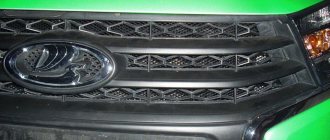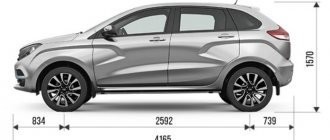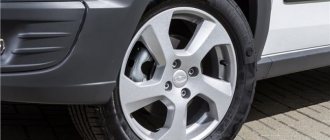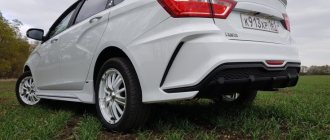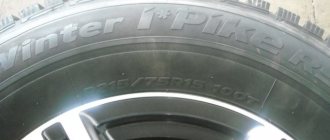Reading time: 7 minutes
Since 2015, a fundamentally new project of the AvtoVAZ concern called Lada Vesta has become available to Russian car enthusiasts. Considering the presentable appearance, modern powerful power units for this class with a volume of 1.6 or 1.8 liters, automatic transmission and other comfortable options, this vehicle has become the best-selling domestic car.
The plant’s engineers did not stop there; since the end of 2017, a unique modification of the brand has been released - the Lada Vesta SW Cross, which is a cross between a station wagon and a compact crossover and is a comfortable family car capable of driving on light off-road conditions in the winter.
Standard factory tires for Lada Vesta SW Cross
Winter tires on SW Cross
The developers tried to achieve a crossover effect from the standard wheelbase of this car. Winter tires on the Lada Vesta SV Cross can only be installed in 17-inch sizes, since these are the wheels that allow you to achieve a maximum ground clearance of 203 mm. The SV Cross modifications are coming off the assembly lines of automakers, having the following basic characteristics of tires installed in the standard version only for use in the summer:
- If we consider only geometric parameters, then the wheels for this modification of the Lada have the same size - 205/50/R17, which allows the car to have a decent appearance, overcome difficult sections of the road, and also not get stuck on soft ground thanks to the wide sole with powerful treads.
- When choosing winter tires for the Lada Vesta SW Cross, drivers should remember that most of these wheels are produced in an all-season version. If they need to choose a good friction or studded tire, they should still change the wheel to R16, since a 55-60 mm side cord is much more reliable when driving on rough terrain in the cold season.
- When a driver operates his car exclusively in a big city, he may well use all-season tires.
- Vesta Cross tire sizes do not offer drivers a rich assortment due to the specific technical characteristics of the vehicle. Absolutely all tires installed as standard on this modification of Vesta have special indexes.
On the profile of the Vesta SV Cross tire you can find the abbreviation M + S, which means Mud and Snow, and translated into Russian - “dirt” and “snow”. This designation does not mean that the tire has excellent grip on the road surface at temperatures below 0 degrees Celsius, but the treads are designed in such a way that the tire has traction properties on almost any surface down to -10 degrees.
Winter tires for Lada Vesta SW Cross
- The last important point when choosing tires for a given car is the shi indices. Considering the model’s ability to overcome areas with poor road quality, as well as the ability to accelerate to a speed of 190 km/h, these parameters in the factory version vary from 89V to 93W. These figures mean that when inflated, each wheel can withstand a load of up to 580-650 kg, and you can safely drive in this state at a speed of 240-270 km/h for at least 30 minutes without the risk of dismantling.
Standard sizes
The main goal of the developers of LADA Vesta SW CROSS was to create a car with increased ground clearance. From the factory, this car is produced only on 17-inch wheels. Thanks to this, the car's ground clearance is an incredible 203 mm.
LADA Vesta SW CROSS
The only basic tire size is 205/50/R17. This is enough to give the car:
- attractive appearance;
- excellent cross-country ability;
- ability to overcome light off-road conditions.
All this is achieved due to the wide contact of the tire. If you are looking for winter tires for the LADA Vesta SW CROSS, you should know that most options will be all-season.
If you want to give your car excellent cross-country ability in difficult winter conditions, a better decision would be to opt for R16 studded tires with a profile height of 55-60%. This will allow you to move comfortably over rough terrain.
Studded tires size R16
If the car is used exclusively in city conditions, then the size of winter tires on the Lada Vesta SV Cross can be left as standard. Its performance indicators will be enough to make you feel comfortable driving a domestic crossover.
How to choose the right winter tires for Lada Vesta SW Cross
- If the driver drives his Lada exclusively in the city, then the all-season M + S version with hard treads that will not wear out quickly during sharp braking or when turning on asphalt surfaces will suit him.
- When the vehicle is operated on country roads, or in the region where the driver lives, the air temperature often drops below -10 degrees Celsius, then it is simply impossible to do without full-fledged winter tires. And it’s even better if it is equipped with multi-directional metal spikes, which will ensure the stability of the car during acceleration, braking and cornering.
- If the car is planned to be used on rough terrain with completely snowy roads, then a studded tire will be unnecessary, because the studs play virtually no role in traction, and the main function is taken over by the soft tread. Thus, a car enthusiast should purchase a friction tire, the surface of which is cut into numerous lamellas with sharp edges.
Friction tires on Lada Vesta SW Cross
These elements, when pressed on them under the weight of the car, move apart, forming dozens of cracks, into each of which snow mass falls, lingering there for a certain time.
If excess moisture forms under the wheels (for example, at zero temperature outside the window, when the snow turns into mush), then it is effectively removed through special grooves for collecting water between the blocks of lamellas.
- When choosing wheels, a car enthusiast can turn not only to companies that are authorized brands of the concern, but also to other brands whose products are adapted for normal use in the middle zone. This means that the chemical composition of the rubber must be selected in such a way that the protectors do not harden even at extremely low temperatures.
It is advisable to select tires that contain admixtures of silicate materials and create an abrasive surface during wear. The most popular brands for Russian car enthusiasts are Nokian, Bridgestone, Pirelli, Michelin, Amtel, Viatti and some other companies that are widespread in the Russian Federation.
What other tire parameters are recommended for the Lada Vesta Cross?
In addition to the listed characteristics, this model represents a technological breakthrough in the long history of the Lada brand. These adjustments relative to the classic modifications could not but affect the characteristics of the wheels, which have the following distinctive features:
- The recommended wheels for Vesta SV Cross in size 17 are at odds with the understanding of budget tires for the Russian consumer. The wheel rim parameters for this modification are 6.5J x 17 ET43 - this is a very rare size to find a worthy replacement.
- Installing tires with a diameter of 16 inches with a complete replacement of wheels will cost almost the same as purchasing new tires with a mounting diameter of R17. At the same time, having assembled wheels in the garage will allow the car enthusiast to save money and time on tire fitting for 4-5 seasons in a row, which will fully cover the costs. If you already have carefully balanced wheels, the car enthusiast can do this procedure independently, having with him only a wheel wrench and a compressor with a pressure gauge for inflating the tires.
Typical tire size
So, to better understand the type of tires, let's look at the table that shows the main indicators. After carefully studying the data, the choice of tires for the Vesta SV Cross with the following parameters becomes obvious: 205/50 R17.
In fact, AvtoVAZ recommends using these. Moreover, this type of rubber may have different load capacity and speed indices.
If the owner installs wheels that require a slightly different type of tire, it is permissible to use slightly wider (215) and narrower (195) tires. The table below shows typical options for wheels and tires that can be installed on the Lada Vesta SV Cross.
| Acceptable tire and wheel options | |
| Tires | Discs |
| 195/65 R15 | 6.0Jx15 ET37 |
| 205/55 R16 | 6.0Jx16ET40 |
| 205/50 R17 | 6.5Jx17 ET41 |
| 205/45 R18 | 7.0Jx18 ET38 |
| 215/45 R17 | 7.0Jx17 ET38 |
| 215/40 R18 | 7.0Jx18 ET38 |
From the table we can draw a simple conclusion: if you need higher tires, you need to install wheels of a smaller diameter. So, to install the highest (65) tires, you will need 15-inch wheels.
Video review of tires on Lada Vesta SV Cross:
Clarifications on acceptable wheel sizes for Cross and Sport versions of LADA cars
AVTOVAZ recommends installing only one size of tires and wheels on the Cross and Sport versions (on Vesta Cross, XRAY Cross and Vesta Sport only 17-inch wheels, on Largus Cross only R16, and Granta Cross only R15). These permissible tire and wheel sizes are indicated in the vehicle owner's manual. However, when checking a car, government agencies are guided by the requirements that are specified in the documents drawn up when certifying a car before starting sales in the country - VTTS (Vehicle Type Approval). The Lada.Online website studied these documents and discovered an interesting feature.
The OTTS number is indicated in the title of your vehicle. We find it on the Internet and look at the acceptable tires.
Decoding tire markings
However, not everyone finds it easy to understand the large number of parameters with which tires are marked.
As a rule, when choosing tires, buyers focus only on the diameter, width of the rubber profile and height, after which the speed and load capacity index are selected.
Now let’s look at what this or that inscription on car tires means. Let's do this using the example of a tire marked 195/65 R15 91 T XL. In this case, the manufacturer and the specific model are not important, we are only interested in the marking itself.
The first number in the marking always indicates the width of the tire in millimeters. The sample in question has a diameter of 195 mm.
The next number is the tire height. 65 is the percentage of height to width. With simple steps we get approximately 127 mm (65% of 195).
Next comes the English letter R. Contrary to the opinions of many car owners, it does not mean the size, that is, the radius, of the tire, but denotes the tire manufacturing technology. R - radial cord. All types of tires for cars are produced using this technology.
To be fair, it is worth noting one more meaning of the designation of the letter R, but not independently, but in tandem with the number following it (in the example - 15). This marking indicates the inner diameter of the tire and, accordingly, the diameter of the rim to which it fits.
Let's go further and see the number 91. This is the same tire load index. The tables below will show the values of the indices and the corresponding values of the maximum loads in kilograms. In our case, the maximum load is 615 kg. For the most part, car owners do not pay much attention to these indicators, since these are not critical values for passenger cars. These numbers are much more important for trucks.
Next is the letter T, indicating the speed index. Simply put, this parameter indicates the maximum speed of the vehicle on which certain tires are installed. Let's turn our attention to the table above again, but this time at number two. In it you can see that the speed index under the letter T is 190 km/h.
Lada Granta Cross and Kalina Cross
The owner's manual specifies only one size of acceptable tires and wheels: 195/55R15. And the OTTS indicates the following permissible dimensions:
- 175/70 R13
- 175/65 R14
- 185/60 R14
- 185/55 R15
- 195/55 R15
- 195/50 R15 (only in OTTS Kalina)
There are no restrictions for the Cross version, however, when choosing wheel rims, take into account the size of the brake discs installed on the car. It turns out that you can legally install R14 or even R13 wheels on Granta/Kalina Cross.
What tire pressure is needed for Vesta SV Cross
Well, we’ve sorted out the wheel markings, let’s move on to such an important parameter as pressure. Pressure is measured in atmospheres and factors such as:
- vehicle handling;
- comfort when moving;
- tire durability;
- disk integrity.
Too high tire pressure when driving, especially on rough roads, will lead to early tire failure due to wear of the tread in the central part of the wheel.
At the same time, low pressure will ensure a smooth and soft ride of the car. However, a car with such wheels is less controllable at high speed. In addition, there is a possibility of increased tire wear along the edges of the wheel. The rims of your car may also be damaged.
When driving into a hole, tires with low pressure will not be able to provide the necessary protection, which may cause part of the disk to bend.
What tire pressure should I choose for the Lada Vesta SV Cross? Recommended values are 2.1 - 2.5 atmospheres. The pressure is selected based on the driving style and the required driving comfort. However, you should not go beyond the recommended parameters.
what in wheels 17 radius, R16, P15
Ride comfort indicators depend 70% on the size of the wheels and the correct inflation. This car is equipped with three types of wheels, and for each version the recommended tire pressure for the Lada Vesta is different.
| Dimensions | Recommended pressure At. | |
| Front axle | Rear axle | |
| 195/65 R15 | 2.10 | 2.10 |
| 205/55 R16 | 2.10 | 2.10 |
| 205/50 R17 | 2.30 | 2.30 |
An important parameter is the actual load of the machine. The above values are relevant for 4 adults in the car. If there is an additional load of about 100 kg inside the trunk. 0.1-0.2 units should be added to the nominal values. The company insists on timely monitoring of correct tire inflation. In the absence of proper care, a decrease in actual indicators by more than 15% from the standard, such negative effects may occur.
- Accelerated wear of the tread.
- Reduced steering sensitivity.
- Increased braking distance.
- Increased fuel consumption.
- The likelihood of hydroplaning on wet asphalt increases.
To facilitate control, a TPMS system is installed on board the machine, which automatically measures tire inflation in real time. Thus, it is almost impossible to “mess up” the release wheel.
Tire pressure Lada Vesta SW
The station wagon version of the car does not require a unique approach to inflating the wheels. The same indicators are relevant here as for ordinary Vesta. However, the owners of the model, based on practical experience, recommend slightly adjusting the indicators. It is better to present all information in a table.
| Wheel size | Pressure at minimum load | Pressure at maximum load | ||
| Before | Back | Before | Back | |
| R15 | 2,10 | 2,10 | 2,10 | 2,20 |
| R16 | 2,10 | 2,10 | 2,10 | 2,20 |
| R17 | 2,30 | 2,30 | 2,40 | 2,40 |
Vesta sedan tire pressure
The sedan version is supplied to the market with P15 or P16 wheels. The optimal pressure inside the tires is the same as for a station wagon. The only exception is recommendations from car owners. For unpaved roads or bumpy asphalt sections, users are of the opinion that when the indicator decreases by 0.2 At, the vehicle behaves more comfortably - the sensitivity of the suspension improves, and bumps are felt less. If the buyer actively drives the car. On the contrary, it is recommended to increase the nominal thresholds by 0.2-0.3 Bar. This is argued by reducing the likelihood of puncture or damage to the wheel rims. Also, tight tires grip hard surfaces better and improve rolling performance.
Tire pressure Vesta SV Cross
The cross version differs from its predecessor with more aggressive body kits and reinforced suspension. However, the changes did not affect the wheels of the car. Wheels with a radius of 15, 16 and 17 inches are also relevant. Actually, the same as the recommended tire pressure. The only exception is driving on unpaved roads - the company insists on increasing the figure by 0.2 At for the front and rear axles, respectively. Motorists insist that, if necessary, the air volume can be bleed by 10% to improve comfortable performance. But here the on-board TPMS system is activated. If the gap between actual and reference is too large, the instrument panel display will notify the driver that a boost is needed.
Vesta tire pressure in winter and summer
During seasons of critical ambient temperatures, it is necessary to check the pressure inside the tires at least 3 times a month. This is argued by the fact that when the temperature increases or decreases, the air changes volume.
For example, a situation is simulated: a car is moving at +40 °C on a highway. At the same time, under the influence of heat and friction, the tires heat up, and the compression of the air inside increases. Thus, diagnostics must be performed every 350-400 km, and the indicators must be equalized to the standard values (usually fluctuations are no more than 0.3 BAR).
In winter, on the contrary, the temperature drops, the on-board panel may display the following sign:
This is normal TPMS processing. With this icon, the car says that you need to pump up the tires to the specified level. Usually the difference with the standard is no more than 0.3 At.
Choosing tires for Lada Vesta Cross
For the most correct and accurate choice of tires for the Lada Vesta Cross, it is worth considering the conditions in which the car will be used most of the time. If you live in a city and plan to drive exclusively on good, smooth roads, you can install low-profile tires. If you need to travel outside the city or often get out into nature, you should give preference to a higher profile. This way the car will have greater driving comfort.
In addition to the height of the rubber profile, comfort is also affected by the noise emanating from the rubber when driving. To achieve less noise, you need to buy softer tires. And, of course, it’s worth choosing the right tread type. There are mainly four types available for sale:
- symmetrical directional;
- symmetrical non-directional;
- asymmetrical non-directional;
- asymmetrical directional.
Let's look at each type in more detail.
Symmetrical directional
Tires with this type of tread are suitable for those who like to drive fast. The advantage of this type is its resistance to aquaplaning, since the tread perfectly drains water when entering the water. The disadvantage of these tires is considered to be increased noise.
Symmetrical omnidirectional
This type of tire is distinguished by its versatility. Yes, tires with such a tread do not drain water so well, but they are suitable for drivers who prefer normal driving speeds. The advantage of tires with a symmetrically directed tread is that a car equipped with them behaves confidently both on gravel and on asphalt roads.
Asymmetrical omnidirectional
A closer look at tires with asymmetrical non-directional treads will reveal that they have a stiffer outer portion. Due to this, such rubber has increased resistance to damage. At the same time, the inside of these tires is responsible for draining water. The central part of the tire is designed for overall stability. Of course, the stiffer parts provide obvious advantages, but they are also responsible for a significant disadvantage of these tires.
Due to its increased rigidity, this type of rubber extremely weakly absorbs vibrations when driving.
Asymmetrical directional
The least common tire option. This type has been discontinued. The main feature of this rubber was increased drainage with smooth load distribution. But its main drawback was the need to have 2 spare wheels at once. If something happens to a wheel, you need to change a couple of wheels at once, which, you see, is extremely inconvenient.
After familiarizing yourself with each type of rubber, you can make your choice. Yes, it is difficult to choose the ideal tires for your car, since each of the types listed has both obvious advantages and undeniable disadvantages. When choosing, you should rely on your driving style, climate and conditions of use of the car.
Types of tires with examples of specific models
To select the correct tires for the Lada Vesta SV Cross, the first thing you need to do is decide on the terrain and conditions in which the car will be operated. If the car only drives on smooth city roads, then low-profile tires are the best option.
A very important parameter is tire noise. Soft rubber can provide maximum comfort of movement. The design of the projector is also very important. The following types are currently common:
- directed;
- non-directional.
They, in turn, are divided into symmetrical and asymmetrical types of tires. The symmetrical directional tread pattern is ideal for driving at high speeds. It also demonstrates excellent performance when driving in wet weather: water is well removed from the stain. These tires are somewhat noisy. The most inexpensive option among similar ones is the DoubleStar DW09 with a price of 2,900 rubles per wheel.
Tires DoubleStar DW09
The most universal tread pattern is symmetrical non-directional. These tires are suitable for any operating conditions and will allow the driver to feel comfortable on any road. The budget option among these models can be considered Nankang ESSN-1. Its cost is just under 5 thousand rubles.
Tires Nankang ESSN-1
In asymmetrical non-directional tires, the outer part has a more rigid structure, which is resistant to damage. The inner side is responsible for draining water, and the center provides directional stability. The most affordable option of this type can be considered Ovation Tires W-586 tires with the cost of one tire starting from 3,300 rubles.
Tires Ovation Tires W-586
Winter tires for Lada Vesta Cross
If you need winter tires for your Lada Vesta Cross, you should contact one of the many online stores where you can specify the wheel parameters you need and all you have to do is choose. The easiest way is to go to Yandex.Market, open the Auto category and select Tires. In the parameters, enter 205/50 R17 if you are using standard wheels, or any other value for your wheels.
In addition, you can select the “Discounts and promotions” category and save on your purchase. As a result, we get a lot of options from various manufacturers in the price range from 2,500 to 18,700 rubles per wheel. Among them there are both friction and studded types of rubber. Which one is preferable is up to you to decide, based on your available budget and personal preferences.
Remember that high-quality tires, if used correctly, will serve you for several seasons and will ensure a comfortable ride and safety on the road.
Not long ago, sales of the Lada Vesta SV Cross station wagon with a 1.8 engine started. In principle, this model is very much reminiscent of modern foreign vehicles, which is good news. One of the distinctive characteristics of this off-road vehicle is the huge seventeen-inch alloy wheels. As a result, the car requires special tires. We’ll talk about choosing tires for the Lada Vesta SV Cross with a robotic gearbox now.
Verdict
Changing your Lada Westa SW Cross to winter tires is not cheap. The total cost of tires and tire fitting is at least 23,000 rubles. For this money, the factory 205/50 R15 wheels will have the Kumho WinterCraft ice Wi31 middle class stud. The alternative is to break the law: then for the same amount you can get good 195/65 R15 tires and alloy wheels.
Uncompromising tires – Nokian Hakkapeliitta 9, R3 and Continental ContiIceContact 2 and ContiVikingContact 6. Significant costs are justified by reasonable behavior on any surface. Among Velcro, the popular choice is Nokian Nordman RS2. The optimal studded tire is Nordman 5, 7.
Reading time: 7 minutes
Since 2015, a fundamentally new project of the AvtoVAZ concern called Lada Vesta has become available to Russian car enthusiasts. Considering the presentable appearance, modern powerful power units for this class with a volume of 1.6 or 1.8 liters, automatic transmission and other comfortable options, this vehicle has become the best-selling domestic car.
The plant’s engineers did not stop there; since the end of 2017, a unique modification of the brand has been released - the Lada Vesta SW Cross, which is a cross between a station wagon and a compact crossover and is a comfortable family car capable of driving on light off-road conditions in the winter.
Standard factory tires for Lada Vesta SW Cross
What do tires affect?
It is worth noting that car tires play a very important role. This element affects such parameters as:
- maximum speed and acceleration of the car;
- controllability and braking distance;
- amount of fuel consumed;
- wear of the chassis, etc.
Thus, it is very important to carefully select tires, and also use only those tires that are provided by the manufacturer.
What does tire marking mean?
To choose high-quality tires, you need to understand what this or that icon on the element label means. First of all, the designation can be divided into several groups:
- width. Indicates the dimensions of the element in millimeters. The standard figure reaches 205 mm;
- height percentage. It is written with a slash. In fact, the tire height on the Lada Vesta SV Cross should reach 102.5 mm;
- tire type The letter R indicates that the tires come with a radial cord. There cannot be any other designations here, since modern tires are made only using this technology;
- disk dimensions. The number after R is the diameter of the disk in inches (in fact, in our station wagon this figure is 17 inches);
- rubber marking. It indicates the maximum load permissible on one wheel. In principle, passenger transport does not depend much on this parameter; it has more to do with trucks;
- speed index. Next in the marking is a letter that indicates what maximum speed the tire can withstand;
- additional designations. Some symbols indicate that the tire is heavy-duty (XL), all-season (M+S), rain, etc.
There are some additional symbols, for example, indicating the direction of the tread, but the basic symbols are enough to choose the appropriate option.
What should the pressure be?
Another important indicator is tire pressure. If you constantly monitor this parameter, it will not only improve the car’s handling, but also the comfort of passengers and the driver. In addition, the optimal pressure level contributes to long-term operation of tires and wheels.
High pressure reduces interior comfort and also increases tire wear. Low results in increased comfort, but significantly reduced controllability. In addition, in this case, the tires are very easily damaged by sharp and hard objects that may come across on the road.
The optimal pressure indicator for LADA Vesta SW Cross tires is 2.1-2.5 atmospheres, based on the driving style and preferences of the car owner. You should check this parameter regularly and, if necessary, inflate the tires.
Pressure recommendations for winter
A very important indicator for tires is pressure. It is this parameter that affects the following characteristics:
- car controllability;
- comfort of movement;
- safety of rubber and duration of its operation.
Too high tire pressure will create discomfort when driving over uneven surfaces, and will also lead to increased wear of the tread pattern in the center of the wheel.
It is important to monitor tire pressure while driving the vehicle.
The most optimal pressure for tires installed on LADA Vesta SW CROSS is 2.1 – 2.5 atm. It all depends on the chosen driving style, as well as comfort requirements. It is not advisable to overinflate the wheels and vice versa.
Features of choosing a tread
First of all, here you need to start from the operating features of the vehicle. Low-profile tires are also suitable for urban conditions. If you plan to drive on dirt roads or off-road, then you will have to take higher tires. In addition, the noise level of the tires should also be taken into account. To make the ride more comfortable, you should pay attention to soft tires.
Based on the type of pattern, there are four types of protectors:
- symmetrical directional. The best option if you plan to drive at high speeds. At the same time, the models are resistant to aquaplaning. This pattern is well suited for high-quality drainage of water upon contact. The main disadvantage is high noise;
- symmetrical non-directional. A universal option that maintains an optimal balance between efficiency and comfort. Perhaps the water drainage rates here are not the highest, but the tires are quite good for slow water. At the same time, it will be comfortable to drive both on gravel and on the highway;
- asymmetrical non-directional. The outer part is characterized by increased rigidity, while the inner element is designed for improved drainage. The center of the rubber is designed in such a way as to increase directional stability. The disadvantage comes down to poor absorption of vibration vibrations due to the rigid center and external element;
- asymmetrical directional. Such models are the most difficult to come across, since they are practically not produced now. The elements were produced in order to smoothly distribute the load over the entire surface of the tires, as well as ensure the highest quality drainage. At the same time, car owners had to carry two spare tires with them, which led to a decrease in demand for this option.
It is worth noting that there is no ideal option here; each type of tire has its own advantages and disadvantages, so the choice must be made based on the driving style, as well as the operating conditions of the vehicle.
How to choose winter tires for LADA Vesta SW Cross
You can buy such items at any auto store in your hometown, or via the Internet. In the latter case, it is not always possible to choose the vehicle model, so here you will have to search by size.
There are no problems at all with summer models - there are almost 100 different options available. With winter tires, things are somewhat more difficult, but even here the assortment is very wide - depending on the store, you can choose from 10-40 models. In this case, tires come in both friction and studded types.
The cost is very high (20-30 thousand rubles per set), but this is not worth saving. Moreover, such a set, with proper driving, will easily last for three to four years.
A few final words
Thus, tires for the Lada Vesta SV Cross are somewhat different from most tires in recent car models from the AvtoVAZ brand, which is due to the increased diameter of the wheels (17 inches). It is worth noting that there are now many different tire models available, which differ in their performance and cost.
In any case, it is advisable to choose those options that meet the requirements of automakers, and also not to save money. It is better to buy tires in trusted auto stores - this way you can be as confident as possible in the reliability and durability of the purchased elements.
Next is an interesting decision about what tires to put on your Lada Vesta SV Cross for the winter:

